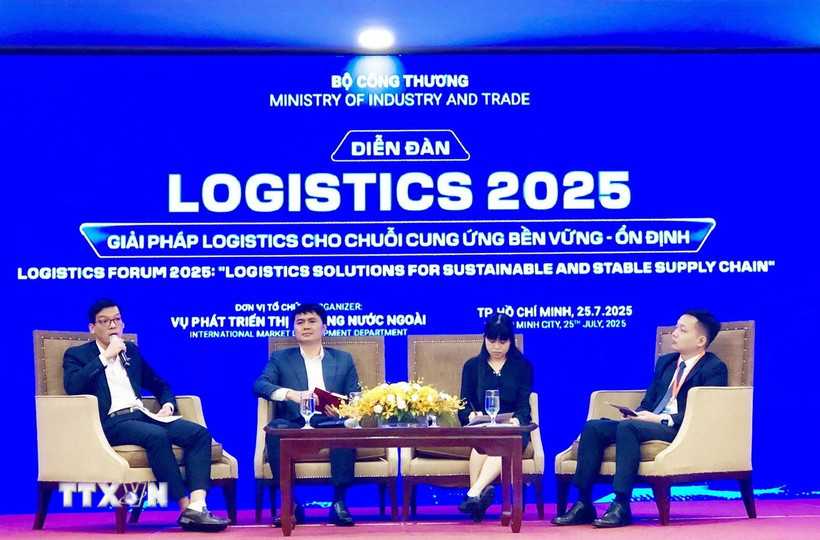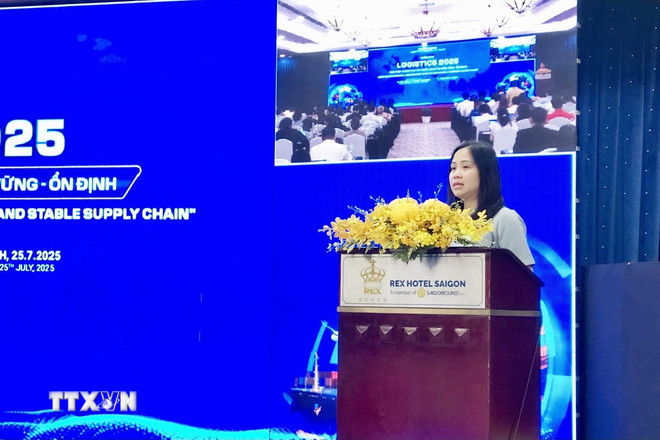 Experts and business representatives participate in the discussion session at the Forum. (Photo: My Phuong/VNA)
Experts and business representatives participate in the discussion session at the Forum. (Photo: My Phuong/VNA)
The logistics market in Vietnam is forecast to continue to grow in the second half of 2025 thanks to the general prospects from the scale of trade and the potential of new large-scale industrial parks after the merger of localities.
In particular, the Government is strongly promoting the progress of public investment, encouraging the private sector to participate in order to improve the efficiency of logistics services in Vietnam.
This is the information given by many experts at the Logistics Forum 2025 organized by the Department of Foreign Market Development, Ministry of Industry and Trade in Ho Chi Minh City on the afternoon of July 25.
According to experts, the shift of global supply chains and FDI into Vietnam is expected to increase if the tax rate that Vietnam achieves in the agreement with the United States is more favorable than some other countries in the Asian region. However, the logistics industry also faces challenges of increased operating costs due to the general increase in commodity prices and businesses need time to get used to new domestic and international legal regulations that have been issued simultaneously recently.
Specifically, Deputy Director of the Center for Industry and Trade Information, Ministry of Industry and Trade Dinh Thi Bao Linh pointed out that as a highly open economy, logistics activities in Vietnam are closely linked to the external environment.
In addition, the scale of import and export activities, foreign investment projects in Vietnam as well as a part of investment projects from Vietnam to foreign countries will require the logistics industry to have solutions for a sustainable and stable supply chain.
Furthermore, in the context of global trade and investment continuing to develop complicatedly from April 2025 to present, the logistics business community must continuously change, predict, adapt and constantly strive to improve resilience and competitiveness to survive in a rapidly changing environment.
In parallel, the different tariff rates that the United States applies to each partner also come with corresponding requirements on the origin of goods to clearly determine the correct tax rate applied to the list of goods groups from different countries.
On the other hand, the new space after the merger of localities requires a new and clear strategy in infrastructure exploitation, allocation of logistics centers and building the ability to integrate transportation-storage-distribution. Therefore, in addition to the joint efforts of the industry and trade sector and customs forces, good control of goods origin, legal and transparent transshipment activities really need the cooperation of the transportation and logistics business community in Vietnam.
Solutions to adjust the logistics service business model include building satellite distribution centers (mini-hubs) at strategic transit points, including Di An, Binh Duong (old); Nhon Trach, Dong Nai, Phu My, Ba Ria-Vung Tau (old) ... to help shorten delivery time, reduce the load on the main warehouse and increase the ability to serve multiple points. Or move some large logistics facilities outside the core urban area to reduce rental costs, in line with the green logistics development strategy, aiming at energy-saving operations and reducing emissions.

A representative of the Ministry of Industry and Trade updates information on the logistics market in Vietnam. (Photo: My Phuong/VNA)
Deputy Director of the Center for Industry and Trade Information, Ministry of Industry and Trade Nguyen Thao Hien said that in addition to developing the market and boosting import and export, the Ministry is always interested in promoting logistics activities and services because these are inseparable fields.
With the theme "Logistics solutions for sustainable and stable supply chains," the Forum is not outside the goal of accompanying businesses in digital-green transformation and bringing sustainable development factors to maintain market share, as well as diversify markets.
Typically, the global logistics landscape in the second half of 2025 is being shaped by a number of key trends such as digitalization, automation, route changes, trade flows and logistics. Therefore, global logistics is posing new requirements such as ensuring compliance with new regulations and policies; being proactive, cooperative, applying technology, innovating management to overcome disruptions, incidents, and recovery; aiming for sustainable development...
Given this reality, the global supply chain in the second half of 2025 is expected to continue to be complex and disrupted, due to geopolitical instability, changes in trade policies and the continuous integration of new technologies.
Enterprises must proactively optimize supply sources, build sustainable partnerships and leverage technology to enhance resilience, response and development such as transportation management systems (TMS), warehouse management systems (WMS), fleet management systems (FMS) and AI routing technology.
From the association's perspective, Mr. Juergen Weber, Chairman of the Transport and Logistics Subcommittee, European Chamber of Commerce in Vietnam (EuroCham) recommended that Vietnam needs to accelerate infrastructure development and modernize the logistics industry through policy mechanisms to facilitate logistics projects to attract investment in diverse forms and receive technology transfer. The policy mechanism for the development and management of the logistics industry also needs to ensure uniform development planning across the country or in potential key areas, in order to unblock the logistics supply chain.
Mr. Juergen Weber also said that in the process of attracting investors, there should be a policy mechanism to prioritize new technologies that are adaptable and participate in the global supply chain to reduce costs for the logistics industry.
Another important issue is training human resources for logistics professionals to meet the requirements of rapid adaptation to free trade integration, participation in the global supply chain and operation of a digital-green logistics system.
Based on 8 years of extensive development experience in the China-Vietnam logistics sector, Mr. Truong Ton Vi, General Director of Viet Thong Company (Viet Nam Express) expressed his desire to cooperate more deeply with Vietnamese logistics enterprises and industry associations in the future.
When the logistics resources of the two countries are deeply integrated and the multimodal transport network is more seamless, the potential for China-Vietnam trade will be further expanded.
Statistics for the first 6 months of 2025 show that Vietnam's freight volume reached 1,438.59 million tons, up 14.28% over the same period in 2024.
Many domestic and foreign enterprises believe that promoting multimodal transport, especially exploiting railway transport, when the Government has many policies to develop and connect Vietnam's transport routes, along with programs to promote the improvement of Vietnam's logistics supply chain, will bring many opportunities for both localities and enterprises./.